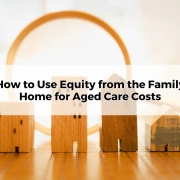Impact of Market Trends on Aged Care Costs
Table of Contents
ToggleUnderstanding the factors that influence aged care costs is crucial for Australian families planning for retirement and aged care. Over recent years, various market trends have impacted the financial landscape of aged care, affecting the affordability and accessibility of these services. From demographic shifts to inflation, this article explores how current market trends influence aged care costs and the financial planning strategies to address them.
Introduction to Market Trends and Aged Care Costs
Market trends in aged care encompass economic, demographic, regulatory, and technological shifts that influence the costs and delivery of aged care services. From changes in workforce availability to rising operational expenses, these trends significantly impact the affordability and quality of aged care across Australia.
Understanding market dynamics is critical for financial planning, as trends directly impact aged care affordability, especially for low-to-middle-income Australians. Monitoring these trends allows families to anticipate cost fluctuations, adjust savings strategies, and maximise available resources for future care needs.
Demographic Changes and the Rising Demand for Aged Care
Australia’s ageing population is one of the most significant factors driving demand for aged care. The proportion of Australians aged 65 and over is projected to increase substantially over the coming decades. This demographic shift will place pressure on the aged care system, increasing competition for services and, consequently, costs.
With Australians living longer, there is a growing need for prolonged and complex care. As life expectancy rises, aged care facilities face increased demand for resources to accommodate these extended stays, contributing to higher costs across the board.
Inflation and Its Direct Impact on Aged Care Costs
Inflation affects aged care in numerous ways, including the cost of essentials like food, utilities, and medical supplies. As inflation rises, aged care facilities pass these increased operational costs on to residents, raising fees and out-of-pocket expenses for families.
Wage inflation, driven by the need to attract and retain skilled carers, significantly impacts aged care costs. As demand for qualified workers grows, providers are compelled to offer competitive wages, which ultimately raises service fees for consumers.
Government Policies and Funding Changes
Government funding is a key determinant of aged care affordability. Fluctuations in funding, especially for home care and residential care, have a direct impact on out-of-pocket expenses for consumers. When government funding falls short, individuals bear a larger financial burden for care services.
Recent and potential reforms, influenced by the Aged Care Royal Commission, are shaping the financial landscape of aged care. Adjustments in fee structures and policy changes may shift more costs to individuals, highlighting the importance of staying informed about new regulations.
Supply and Demand Dynamics in Aged Care Facilities
A shortage of available aged care facilities and beds creates upward pricing pressure, especially in high-demand urban areas. Limited availability in metropolitan areas drives costs higher, making it difficult for many families to secure affordable aged care placements.
Regional differences in facility availability and pricing underscore the importance of location in aged care affordability. While rural areas might have lower costs due to less demand, accessing services in these regions can be challenging, adding logistical considerations to financial planning.
Real Estate Market Trends and Aged Care Affordability
The property market significantly affects older Australians’ capacity to fund aged care. When real estate prices are high, homeowners may leverage home equity for aged care expenses. Conversely, market downturns can reduce available funds, necessitating alternative financial planning.
Downsizing has become a common strategy for seniors to free up funds for aged care. However, this decision involves estate planning and family dynamics, making it essential to weigh the financial benefits of downsizing against potential impacts on inheritance and familial relationships.
Interest Rate Changes and Aged Care Financial Products
Interest rates influence the affordability of financial products commonly used in aged care, such as reverse mortgages. Higher rates can increase repayment burdens, while lower rates may encourage borrowing to fund aged care expenses.
Low-interest rates can significantly reduce returns on savings, affecting the amount of available funds for aged care. Families relying on interest income may find themselves with a shortfall in funding, requiring alternative planning strategies to cover potential gaps.
Influx of Private Investment in Aged Care
The entry of private operators has transformed the aged care sector, with for-profit facilities often charging higher fees than not-for-profit counterparts. This trend may benefit consumers seeking premium services but also escalates costs for those needing affordable aged care options.
Increased private and public investment in aged care infrastructure is expanding facility availability, potentially easing some pricing pressures. However, high-end investments in infrastructure and amenities can lead to higher fees, particularly in facilities focusing on premium services.
Technology Adoption in Aged Care and Associated Costs
The adoption of telehealth and remote care technologies has grown, particularly since the COVID-19 pandemic. While these innovations improve accessibility, they also add new costs to aged care services, often borne by consumers seeking enhanced medical monitoring.
Aged care providers are investing in automation and digital tools to improve operational efficiency. Implementing technologies like care management software and robotic assistance incurs significant upfront costs, which may translate to higher fees for residents in tech-forward facilities.
Aged Care Workforce Shortages and Costs
Australia’s aged care sector faces a significant workforce shortage, raising wages and driving up service costs. This scarcity of skilled carers makes it more challenging for facilities to meet staffing needs, often resulting in higher fees for residents.
Providers are increasingly investing in recruitment and specialised training to maintain high care standards. However, these initiatives come at a cost, which can contribute to higher prices for aged care services as providers recoup these investments.
Increased Demand for In-Home and Community-Based Care
There is a growing preference for home care, which can often be more cost-effective than residential care. However, increased demand has led to longer waiting lists and rising costs for home care packages, posing challenges for those needing immediate assistance.
High-quality community care services, which include added amenities and specialised support, are increasingly popular. These services, however, come with additional costs, placing financial pressure on families seeking enhanced in-home care options.
The Role of Health and Disability Trends on Aged Care Needs
The prevalence of chronic conditions, such as dementia, is increasing the need for specialised care, which is typically more costly. Facilities equipped to handle these conditions often charge higher fees to cover the additional resources required.
Aged care facilities that cater to residents with disabilities often require special adaptations and staff training, adding to operational expenses. These extra costs are typically passed on to residents in the form of higher fees.
Environmental and Sustainability Trends Affecting Costs
Energy costs and investments in eco-friendly infrastructure, such as solar energy systems, have financial implications for aged care facilities. Although environmentally conscious initiatives may reduce operational costs over time, they often lead to initial fee increases to cover capital expenses.
Implementing sustainable practices, such as water recycling, benefits the environment but can lead to higher operational costs initially. Over time, these investments may reduce utilities expenses, potentially lowering costs for residents in eco-friendly facilities.
Taxation Policies and Their Influence on Aged Care Funding
Changes in taxation policies, such as those affecting superannuation, can impact the funds available for aged care. For example, higher taxes on super withdrawals may limit retirees’ ability to pay for care, necessitating adjusted financial strategies.
Capital gains tax implications can affect seniors selling their homes to fund aged care. Strategic planning around asset sales and potential tax liabilities is essential to maximise available funds for aged care expenses.
Rising Costs of Medical Services and Supplies in Aged Care
Rising medical costs, due to inflation in healthcare services and supplies, affect aged care fees, especially for facilities offering specialised services. This trend is particularly relevant for residents requiring regular medical treatments.
The costs of medications are a considerable expense for aged care residents, especially those on long-term treatments. Pharmaceutical cost inflation can increase out-of-pocket expenses, impacting financial planning for aged care.
Financial Planning Strategies to Manage Rising Aged Care Costs
Setting aside dedicated savings for aged care is crucial. Diversifying investments and considering options like aged care bonds can help families mitigate financial risks related to rising aged care costs.
Understanding government subsidies and eligibility criteria can significantly reduce aged care costs. Familiarity with entitlements helps families access affordable services and manage expenses more effectively.
How Market Trends Affect Future Projections for Aged Care
Based on demographic, economic, and policy trends, aged care costs are expected to continue rising. Financial forecasts can help families anticipate these increases and plan accordingly.
Building contingency plans to cover unforeseen cost increases, such as sudden medical needs, ensures families can maintain financial security while meeting care requirements.
Conclusion
Aged care planning requires flexibility to adapt to economic and policy changes. Regularly reviewing and adjusting plans helps Australians stay prepared for market-driven cost fluctuations.
Financial advisers play a vital role in helping families navigate complex aged care financial landscapes. Tailored advice ensures that individuals and families can prepare for future care needs and protect their financial well-being.









